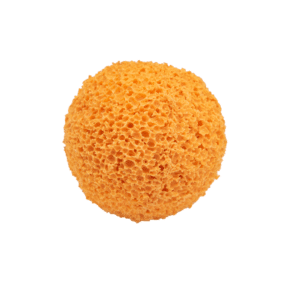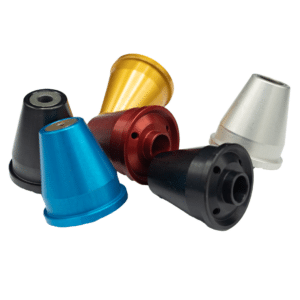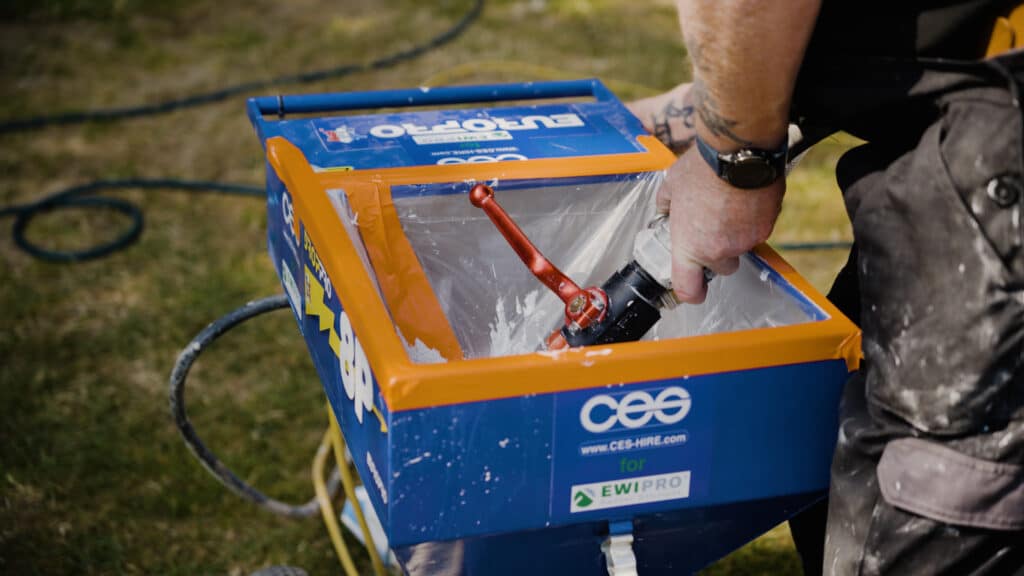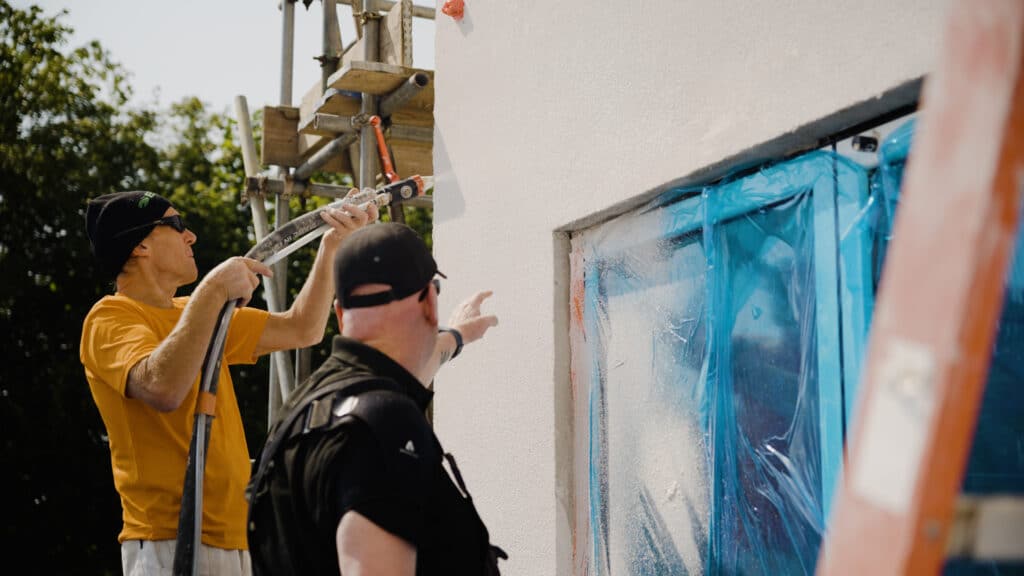A Guide to Spray Machines
Spray machines bring immeasurable benefits to many projects in the building industry. As such, they have become invaluable, particularly in the plastering and rendering world. Many of our installers use spray machines to speed up the application of render and basecoat. Therefore, we have decided to compile a guide to spray machines. In this guide, expect to find a ‘how to’ for using spray machines, their various components and benefits, and some helpful tips. Through our partnership with EWI Pro, we have a unique insight into these tools. The EWI Pro Technical Team delivers Spray Machine Training courses throughout the UK. Therefore, the tips we provide come directly from Messrs. Harris and Christmas, who possess over 55 years of industry experience.
What are spray machines?
Plaster spray machines are innovative tools engineered to speed up the plastering process dramatically. They are specialised pieces of equipment designed to mix and spray plaster onto various surfaces in a continuous, controlled manner.
These machines utilise a motor and a pumping system, capable of handling different types of plaster (from the traditional cement-lime mix to ready-mixed products), to deliver plaster from the machine to the wall or ceiling. It replaces the need for manual plaster mixing and application. This is labour-intensive but also requires a degree of expertise to ensure consistency and smoothness.
By automating the process, plaster spray machines also address the issue of quality. When applied manually, plaster’s consistency can vary depending on the mix and the applicator’s skill. With a plaster spray machine, the mechanical mixing and application process ensures a uniformly mixed plaster and consistent application, resulting in a smoother, more even finish.
Plaster spray machines come in different shapes and sizes. Some advanced models even offer features like adjustable spray nozzles for control over plaster volume and spray pattern.
Components of a spray machine
Most spray machines share the same components as they all work on a similar system.
- Hopper: The hopper serves as the reservoir for the plaster mix. It can be filled manually or mechanically, depending on the machine’s design. In some advanced models, the hopper may also include a mixer or agitator that keeps the plaster mix at a consistent viscosity, preventing the separation or settling of materials.
- Pump: Often referred to as the heart of the spray machine, the pump is responsible for creating pressure. This pressure is necessary for moving the plaster mix from the hopper through the hose. Depending on the model, a plaster spray machine might utilise a piston pump, diaphragm pump, or screw pump. The pump’s power and performance also significantly influence the overall capacity and effectiveness of the machine.
- Hose: This is the critical link between the pump and the spray gun. The hose must be sturdy and flexible enough to withstand high internal pressure while allowing ease of movement for the operator. Hoses also come in varying lengths to accommodate different worksite conditions. The inner surface of the hose is typically designed to reduce friction and prevent clogging, ensuring smooth and uninterrupted flow of plaster.
- Spray Gun: The spray gun is part of the machine where the velocity and direction of the plaster spray are controlled. It is typically equipped with a trigger or lever that, when pressed, releases the plaster onto the surface. Advanced models may have adjustable nozzles to change the spray pattern, enabling the user to customise the finish based on the project’s requirements.
How to use it
First, the plaster mix is poured into the hopper. Depending on the machine, you can pour in pre-mixed and also dry ingredients. The machine’s pump then pushes the plaster up the hose under high pressure. At the spray gun, the operator pulls the trigger to release the plaster. The force created by the pump ensures the plaster then leaves the spray gun at high velocity, covering the wall or ceiling evenly. As the force created is significant, the mixture becomes atomised. As the plaster is sprayed onto the surface, a trowel or similar tool may be used to further smooth out the plaster, ensuring a uniform, high-quality finish.
This process is continuously repeated, allowing large areas to be plastered quickly and efficiently, saving both time and labour costs. The mechanical nature of the process also ensures a consistent finish that can be difficult to achieve with manual methods.
The benefits
One of the most significant advantages of using plaster spray machines is the speed at which they operate. Unlike a manual application, which requires multiple layers and waiting time in between for drying, these machines can cover vast surfaces in a fraction of the time. This speed is not just beneficial in terms of project completion time but also allows for better project planning and management.
Plaster spray machines provide a level of efficiency superior to manual plastering. The even, controlled distribution of plaster results in a smoother finish, reducing the need for sanding and additional finishing work. It also ensures uniform drying, which can improve the structural integrity and appearance of the plastered surface.
Plaster spray machines can bring substantial savings in labour costs due to the reduced time taken to complete a project. Furthermore, they minimise material wastage as the machine delivers the plaster directly where it’s needed. This efficient use of resources makes them a cost-effective solution, particularly for large-scale projects.
The ability of plaster spray machines to handle different types of plaster – from cement and lime mixtures to gypsum-based ones – adds to their utility. This versatility means they can be used in a wide range of projects, accommodating various environmental conditions and aesthetic preferences.
Manual plastering is labour-intensive, and extended periods of such work can lead to physical strain and fatigue. Plaster spray machines mechanise the process, significantly reducing the physical exertion required from workers. This reduction not only boosts productivity but also helps improve worker morale and reduce the risk of work-related injuries.
With their uniform application and consistent mix, plaster spray machines often deliver a higher quality finish compared to manual methods. This leads to aesthetically pleasing results and structurally sound surfaces, which can enhance the overall quality and value of the construction project.
Guide to spray machines – tips
As aforementioned, we have gathered some tips from our Technical Team.
Tip 1 – Take a clear bin bag, poke a hole through the bottom, and then tape it to the inside of the hopper. By doing this, you won’t need to clean the inside of the hopper at the end of the day. You can use any sort of tape to attach it. Just ensure that the bag does not drop down into the mechanism below.
Tip 2 – Always spray into an empty bucket or back into the hopper initially as the initial burst of material is usually lumpy.
Tip 3 – When spraying, avoid unnecessary pauses that can allow the plaster in the nozzle to dry and possibly cause clogs.
Facebook
Twitter
LinkedIn
Your cart
Trade Account Login

We use cookies on our website to give you the most relevant experience by remembering your preferences and repeat visits. By clicking “Accept All”, you consent to the use of ALL the cookies. However, you may visit "Cookie Settings" to provide personalised consent.
Manage consent
Privacy Overview
This website uses cookies to improve your experience while you navigate through the website. Out of these, the cookies that are categorized as necessary are stored on your browser as they are essential for the working of basic functionalities of the website. We also use third-party cookies that help us analyze and understand how you use this website. These cookies will be stored in your browser only with your consent. You also have the option to opt-out of these cookies. But opting out of some of these cookies may affect your browsing experience.
Necessary cookies are absolutely essential for the website to function properly. These cookies ensure basic functionalities and security features of the website, anonymously.
| Cookie | Duration | Description |
|---|---|---|
| __stripe_mid | 1 year | This cookie is set by Stripe payment gateway. This cookie is used to enable payment on the website without storing any patment information on a server. |
| __stripe_sid | 30 minutes | This cookie is set by Stripe payment gateway. This cookie is used to enable payment on the website without storing any patment information on a server. |
| _GRECAPTCHA | 5 months 27 days | This cookie is set by the Google recaptcha service to identify bots to protect the website against malicious spam attacks. |
| apbct_cookies_test | session | CleanTalk sets this cookie to prevent spam on comments and forms and act as a complete anti-spam solution and firewall for the site. |
| apbct_page_hits | session | CleanTalk sets this cookie to prevent spam on comments and forms and act as a complete anti-spam solution and firewall for the site. |
| apbct_prev_referer | session | Functional cookie placed by CleanTalk Spam Protect to store referring IDs and prevent unauthorized spam from being sent from the website. |
| apbct_site_landing_ts | session | CleanTalk sets this cookie to prevent spam on comments and forms and act as a complete anti-spam solution and firewall for the site. |
| apbct_site_referer | 3 days | This cookie is placed by CleanTalk Spam Protect to prevent spam and to store the referrer page address which led the user to the website. |
| apbct_timestamp | session | CleanTalk sets this cookie to prevent spam on comments and forms and act as a complete anti-spam solution and firewall for the site. |
| apbct_urls | 3 days | This cookie is placed by CleanTalk Spam Protect to prevent spam and to store the addresses (urls) visited on the website. |
| AWSALBCORS | 7 days | This cookie is managed by Amazon Web Services and is used for load balancing. |
| cookielawinfo-checkbox-advertisement | 1 year | Set by the GDPR Cookie Consent plugin, this cookie is used to record the user consent for the cookies in the "Advertisement" category . |
| cookielawinfo-checkbox-analytics | 11 months | This cookie is set by GDPR Cookie Consent plugin. The cookie is used to store the user consent for the cookies in the category "Analytics". |
| cookielawinfo-checkbox-functional | 11 months | The cookie is set by GDPR cookie consent to record the user consent for the cookies in the category "Functional". |
| cookielawinfo-checkbox-necessary | 11 months | This cookie is set by GDPR Cookie Consent plugin. The cookies is used to store the user consent for the cookies in the category "Necessary". |
| cookielawinfo-checkbox-others | 11 months | This cookie is set by GDPR Cookie Consent plugin. The cookie is used to store the user consent for the cookies in the category "Other. |
| cookielawinfo-checkbox-performance | 11 months | This cookie is set by GDPR Cookie Consent plugin. The cookie is used to store the user consent for the cookies in the category "Performance". |
| ct_checkjs | session | CleanTalk–Used to prevent spam on our comments and forms and acts as a complete anti-spam solution and firewall for this site. |
| ct_fkp_timestamp | session | CleanTalk sets this cookie to prevent spam on the site's comments/forms, and to act as a complete anti-spam solution and firewall for the site. |
| ct_pointer_data | session | CleanTalk sets this cookie to prevent spam on the site's comments/forms, and to act as a complete anti-spam solution and firewall for the site. |
| ct_ps_timestamp | session | CleanTalk sets this cookie to prevent spam on the site's comments/forms, and to act as a complete anti-spam solution and firewall for the site. |
| ct_sfw_pass_key | 1 month | CleanTalk sets this cookie to prevent spam on comments and forms and act as a complete anti-spam solution and firewall for the site. |
| ct_timezone | session | CleanTalk–Used to prevent spam on our comments and forms and acts as a complete anti-spam solution and firewall for this site. |
| elementor | never | This cookie is used by the website's WordPress theme. It allows the website owner to implement or change the website's content in real-time. |
| viewed_cookie_policy | 11 months | The cookie is set by the GDPR Cookie Consent plugin and is used to store whether or not user has consented to the use of cookies. It does not store any personal data. |
Functional cookies help to perform certain functionalities like sharing the content of the website on social media platforms, collect feedbacks, and other third-party features.
| Cookie | Duration | Description |
|---|---|---|
| __zlcmid | 1 year | This cookie is used by Zendesk live chat and is used to store the live chat ID. |
| bcookie | 2 years | LinkedIn sets this cookie from LinkedIn share buttons and ad tags to recognize browser ID. |
| bscookie | 2 years | LinkedIn sets this cookie to store performed actions on the website. |
| lang | session | LinkedIn sets this cookie to remember a user's language setting. |
| lidc | 1 day | LinkedIn sets the lidc cookie to facilitate data center selection. |
| UserMatchHistory | 1 month | LinkedIn sets this cookie for LinkedIn Ads ID syncing. |
Performance cookies are used to understand and analyze the key performance indexes of the website which helps in delivering a better user experience for the visitors.
| Cookie | Duration | Description |
|---|---|---|
| __utma | 2 years | This cookie is set by Google Analytics and is used to distinguish users and sessions. The cookie is created when the JavaScript library executes and there are no existing __utma cookies. The cookie is updated every time data is sent to Google Analytics. |
| __utmb | 30 minutes | Google Analytics sets this cookie, to determine new sessions/visits. __utmb cookie is created when the JavaScript library executes and there are no existing __utma cookies. It is updated every time data is sent to Google Analytics. |
| __utmc | session | The cookie is set by Google Analytics and is deleted when the user closes the browser. It is used to enable interoperability with urchin.js, which is an older version of Google Analytics and is used in conjunction with the __utmb cookie to determine new sessions/visits. |
| __utmt | 10 minutes | Google Analytics sets this cookie to inhibit request rate. |
| __utmv | 2 years | The __utmv cookie is set on the user's device, to enable Google Analytics to classify the visitor. |
| __utmz | 6 months | Google Analytics sets this cookie to store the traffic source or campaign by which the visitor reached the site. |
| sib_cuid | 6 months | Purechat uses this cookie to send data to purechat.com, to connect visitors to the reservation team and track visitors to stay on portal. |
| SRM_B | 1 year 24 days | Used by Microsoft Advertising as a unique ID for visitors. |
Analytical cookies are used to understand how visitors interact with the website. These cookies help provide information on metrics the number of visitors, bounce rate, traffic source, etc.
| Cookie | Duration | Description |
|---|---|---|
| _ga | 2 years | The _ga cookie, installed by Google Analytics, calculates visitor, session and campaign data and also keeps track of site usage for the site's analytics report. The cookie stores information anonymously and assigns a randomly generated number to recognize unique visitors. |
| _gat_gtag_UA_61069204_2 | 1 minute | Set by Google to distinguish users. |
| _gat_UA-61069204-2 | 1 minute | A variation of the _gat cookie set by Google Analytics and Google Tag Manager to allow website owners to track visitor behaviour and measure site performance. The pattern element in the name contains the unique identity number of the account or website it relates to. |
| _gcl_au | 3 months | Provided by Google Tag Manager to experiment advertisement efficiency of websites using their services. |
| _gid | 1 day | Installed by Google Analytics, _gid cookie stores information on how visitors use a website, while also creating an analytics report of the website's performance. Some of the data that are collected include the number of visitors, their source, and the pages they visit anonymously. |
| _uetsid | 1 day | This cookies are used to collect analytical information about how visitors use the website. This information is used to compile report and improve site. |
| CONSENT | 2 years | YouTube sets this cookie via embedded youtube-videos and registers anonymous statistical data. |
Advertisement cookies are used to provide visitors with relevant ads and marketing campaigns. These cookies track visitors across websites and collect information to provide customized ads.
| Cookie | Duration | Description |
|---|---|---|
| _fbp | 3 months | This cookie is set by Facebook to display advertisements when either on Facebook or on a digital platform powered by Facebook advertising, after visiting the website. |
| ANONCHK | 10 minutes | The ANONCHK cookie, set by Bing, is used to store a user's session ID and also verify the clicks from ads on the Bing search engine. The cookie helps in reporting and personalization as well. |
| fr | 3 months | Facebook sets this cookie to show relevant advertisements to users by tracking user behaviour across the web, on sites that have Facebook pixel or Facebook social plugin. |
| MUID | 1 year 24 days | Bing sets this cookie to recognize unique web browsers visiting Microsoft sites. This cookie is used for advertising, site analytics, and other operations. |
| NID | 6 months | NID cookie, set by Google, is used for advertising purposes; to limit the number of times the user sees an ad, to mute unwanted ads, and to measure the effectiveness of ads. |
| test_cookie | 15 minutes | The test_cookie is set by doubleclick.net and is used to determine if the user's browser supports cookies. |
| uuid | 6 months | MediaMath sets this cookie to avoid the same ads from being shown repeatedly and for relevant advertising. |
| VISITOR_INFO1_LIVE | 5 months 27 days | A cookie set by YouTube to measure bandwidth that determines whether the user gets the new or old player interface. |
| YSC | session | YSC cookie is set by Youtube and is used to track the views of embedded videos on Youtube pages. |
| yt-remote-connected-devices | never | YouTube sets this cookie to store the video preferences of the user using embedded YouTube video. |
| yt-remote-device-id | never | YouTube sets this cookie to store the video preferences of the user using embedded YouTube video. |
| yt.innertube::nextId | never | This cookie, set by YouTube, registers a unique ID to store data on what videos from YouTube the user has seen. |
| yt.innertube::requests | never | This cookie, set by YouTube, registers a unique ID to store data on what videos from YouTube the user has seen. |
Other uncategorized cookies are those that are being analyzed and have not been classified into a category as yet.
| Cookie | Duration | Description |
|---|---|---|
| _clck | 1 year | No description |
| _clsk | 1 day | No description |
| _uetvid | 1 year 24 days | No description available. |
| AnalyticsSyncHistory | 1 month | No description |
| apbct_pixel_url | session | No description |
| apbct_visible_fields_0 | session | No description |
| apbct_visible_fields_1 | session | No description |
| apbct_visible_fields_10 | session | No description |
| apbct_visible_fields_2 | session | No description |
| apbct_visible_fields_3 | session | No description |
| apbct_visible_fields_4 | session | No description |
| apbct_visible_fields_5 | session | No description |
| apbct_visible_fields_6 | session | No description |
| apbct_visible_fields_7 | session | No description |
| apbct_visible_fields_8 | session | No description |
| apbct_visible_fields_9 | session | No description |
| ct_checked_emails | session | No description |
| ct_has_scrolled | session | No description |
| ct_mouse_moved | session | No description |
| ct_screen_info | session | No description |
| ictf_master | never | No description available. |
| li_gc | 2 years | No description |
| m | 2 years | No description available. |
| SM | session | No description available. |
| testinfinitycookie | session | No description |
| woocommerce_show_tax | 7 days | No description available. |
| wp_woocommerce_session_c5ac76b408021294cb56bcc27eddf8a1 | 2 days | No description |









2 thoughts on “A Guide to Spray Machines”
The tips are good but how do you clean all of this? Even the hopper might get dirty if the bag rips
Hi Andy, the bag can rip but you can also cover the inside of the whole hopper with something like our orange tape, which will be more durable. The best way to clean out the delivery hoses and nozzle is whilst the render is still wet; use the foam balls and water to run it through the system and empty into a bucket.